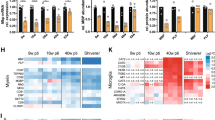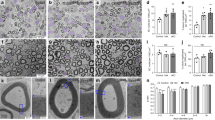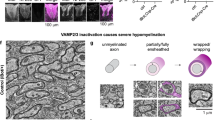Abstract
Myelination of axons by oligodendrocytes enables rapid impulse propagation in the central nervous system. But long-term interactions between axons and their myelin sheaths are poorly understood. Here we show that Cnp1, which encodes 2′,3′-cyclic nucleotide phosphodiesterase in oligodendrocytes, is essential for axonal survival but not for myelin assembly. In the absence of glial cyclic nucleotide phosphodiesterase, mice developed axonal swellings and neurodegeneration throughout the brain, leading to hydrocephalus and premature death. But, in contrast to previously studied myelin mutants, the ultrastructure, periodicity and physical stability of myelin were not altered in these mice. Genetically, the chief function of glia in supporting axonal integrity can thus be completely uncoupled from its function in maintaining compact myelin. Oligodendrocyte dysfunction, such as that in multiple sclerosis lesions, may suffice to cause secondary axonal loss.
This is a preview of subscription content, access via your institution
Access options
Subscribe to this journal
Receive 12 print issues and online access
$209.00 per year
only $17.42 per issue
Buy this article
- Purchase on Springer Link
- Instant access to full article PDF
Prices may be subject to local taxes which are calculated during checkout








Similar content being viewed by others
References
Raine, C.S. Morphology of myelin and myelination. in Myelin 2nd edn. (ed. P. Morell) 1–50 (Plenum, New York, 1984).
Lemke, G. Unwrapping the genes of myelin. Neuron 1, 535–543 (1988).
Trapp, B.D. et al. Axonal transection in the lesions of multiple sclerosis. N. Engl. J. Med. 338, 278–285 (1998).
Giese, K.P., Martini, R., Lemke, G., Soriano, P. & Schachner, M. Mouse P0 gene disruption leads to hypomyelination, abnormal expression of recognition molecules, and degeneration of myelin and axons. Cell 71, 565–576 (1992).
Gow, A. et al. CNS myelin and sertoli cell tight junction strands are absent in Osp/claudin-11 null mice. Cell 99, 649–659 (1999).
Readhead, C. et al. Expression of a myelin basic protein gene in transgenic shiverer mice: correction of the dysmyelinating phenotype. Cell 48, 703–712 (1987).
Boison, D., Bussow H., D'Urso, D., Muller, H.W. & Stoffel, W. Adhesive properties of proteolipid protein are responsible for the compaction of CNS myelin sheaths. J. Neurosci. 15, 5502–5513 (1995).
Rosenbluth, J., Stoffel, W. & Schiff, R. Myelin structure in proteolipid protein (PLP)-null mouse spinal cord. J. Comp. Neurol. 371, 336–344 (1996).
Klugmann, M. et al. Assembly of CNS myelin in the absence of proteolipid protein. Neuron 18, 59–70 (1997).
Griffiths, I.R. et al. Axonal swellings and degeneration in mice lacking the major proteolipid of myelin. Science 280, 1610–1613 (1998).
Sporkel, O., Uschkureit, T., Bussow, H. & Stoffel, W. Oligodendrocytes expressing exclusively the DM20 isoform of the proteolipid protein gene: myelination and development. Glia 37, 19–30 (2002).
Chandross, K.J. et al. Identification and characterization of early glial progenitors using a transgenic selection strategy. J. Neurosci. 19, 759–774 (1999).
Vogel, U.S. & Thompson, R.J. Molecular structure, localization, and possible functions of the myelin-associated enzyme 2′,3′-cyclic nucleotide 3′-phosphodiesterase. J. Neurochem. 50, 1667–1677 (1988).
Sprinkle, T.J. 2′,3′-cyclic nucleotide 3′-phosphodiesterase, an oligodendrocyte-Schwann cell and myelin-associated enzyme of the nervous system. Crit. Rev. Neurobiol. 4, 235–301 (1989).
Tsukada, Y. & Kurihara, T. 2′,3′-cyclic nucleotide 3′-phosphodiesterase: Molecular characterization and possible function significance. in Myelin: Biology and Chemistry (ed. Martenson, R.E) 449–480 (CRC Press, Boca Raton, 1992).
Yu, W.P., Collarini, E.J., Pringle, N.P. & Richardson, W.D. Embryonic expression of myelin genes: evidence for a focal source of oligodendrocyte precursors in the ventricular zone of the neural tube. Neuron 12, 1353–1362 (1994).
Sprinkle, T.J., McMorris, F.A., Yoshino, J. & DeVries, G.H. Differential expression of 2′,3′-cyclic nucleotide 3′-phosphodiesterase in cultured central, peripheral and extra neural cells. Neurochem. Res. 10, 919–931 (1985).
Giulian, D. & Moore, S. Identification of 2′,3′-cyclic nucleotide 3′-phosphodiesterase in the vertebrate retina. J. Biol. Chem. 255, 5993–5995 (1980).
Scherer, S.S. et al. Differential regulation of 2′,3′-cyclic nucleotide 3′-phosphodiesterase gene during oligodendrocyte development. Neuron 12, 1363–1375 (1994).
O'Neill, R.C., Minuk, J., Cox, M.E., Braun, P.E. & Gravel, M. CNP2 mRNA directs synthesis of both CNP1 and CNP2 polypeptides. J. Neurosci. Res. 50, 248–257 (1997).
Agrawal, H.C., Sprinkle, T.J. & Agrawal, D. 2′,3′-cyclic nucleotide 3′-phosphodiesterase in the central nervous system is fatty-acylated by thioester linkage. J. Biol. Chem. 265, 11849–11853 (1990).
Braun, P.E., De Angelis, D., Shtybel, W.W. & Bernier, L. Isoprenoid modification permits 2′,3′-cyclic nucleotide 3′-phosphodiesterase to bind to membranes. J. Neurosci. Res. 30, 540–544 (1991).
De Angelis, D.A. & Braun, P.E. Isoprenylation of brain 2′,3′-cyclic nucleotide 3′-phosphodiesterase modulates cell morphology. J. Neurosci. Res. 39, 386–397 (1994).
Nishizawa, Y., Kurihara, T., Masuda, T. & Takahashi, Y. Immunohistochemical localization of 2′,3′-cyclic nucleotide 3′-phosphodiesterase in adult bovine cerebrum and cerebellum. Neurochem. Res. 10, 1107–1118 (1985).
Kurihara, T. & Tsukada, Y. Regional and subcellular distribution of 2′,3′-cyclic nucleotide 3′-phosphohydrolase in central nervous system. J. Neurochem. 14, 1167–1174 (1967).
Braun, P.E., Sandillon, F., Edwards, A., Matthieu, J.M. & Privat, A. Immunocytochemical localization by electron microscopy of 2′,3′-cyclic nucleotide 3′-phosphodiesterase in developing oligodendrocytes of normal and mutant brain. J. Neurosci. 8, 3057–3066 (1988).
Trapp, B.D., Bernier, L., Andrews, S.B., & Colman, D.R. Cellular and subcellular distribution of 2′,3′-cyclic nucleotide 3′-phosphodiesterase and its mRNA in the rat central nervous system J. Neurochem. 51, 859–868 (1988).
Heaton, P.A. & Eckstein, F. Diastereomeric specificity of 2′,3′-cyclic nucleotide 3′-phosphodiesterase. Nucleic. Acids. Res. 24, 850–853 (1996).
McFerran, B.W. & Burgoyne, R.D. 2′,3′-cyclic nucleotide 3′-phosphodiesterase is associated with mitochondria in diverse adrenal cell types. J. Cell Sci. 110, 2979–2985 (1997).
Laezza, C., Wolff, J. & Bifulco, M. Identification of a 48-kDa prenylated protein that associates with microtubules as 2′,3′-cyclic nucleotide 3′-phosphodiesterase in FRTL-5 Zellen. FEBS Lett. 413, 260–264 (1997).
Bifulco, M., Laezza, C., Stingo, S. & Wolff, J. 2′,3′-cyclic nucleotide 3′-phosphodiesterase: a membrane-bound, microtubule-associated protein and membrane anchor for tubulin. Proc. Natl. Acad. Sci. USA 99, 1807–1812 (2002).
De Angelis, D.A., Cox, M., Gao, E. & Braun, P.E. Cellular and molecular characteristics of CNP suggest regulatory mechanism in myelinogenesis. in A Multidisciplinary Approach to Myelin Diseases (ed. Salvati, S.) 49–58 (Plenum, New York, 1994).
Gravel, M. et al. Overexpression of 2′,3′-cyclic nucleotide 3′-phosphodiesterase in transgenic mice alters oligodendrocyte development and produces aberrant myelination. Mol. Cell Neurosci. 7, 453–466 (1996).
Yin, X., Peterson, J., Gravel, M., Braun, P.E. & Trapp, B.D. CNP overexpression induces aberrant oligodendrocyte membranes and inhibits MBP accumulation and myelin compaction. J. Neurosci. Res. 50, 238–247 (1997).
Akagi, K. et al. Cre-mediated somatic site-specific recombination in mice. Nucleic Acids Res. 25, 1766–1773 (1997).
Bennett, S.A., Stevenson, B., Staines, W.A., & Roberts, D.C. Periodic acid-Schiff (PAS)-positive deposits in brain following kainic acid-induced seizures: relationships to fos induction, neuronal necrosis, reactive gliosis, and blood-brain barrier breakdown. Acta Neuropathol. (Berl.) 89, 126–138 (1995).
Nave, K.-A. Neurological mouse mutants: a molecular genetic analysis of myelin proteins. in Glial Cell Development 2nd edn. (ed. Jessen, J & Richardson, W.) 177–208 (Oxford University Press, New York, 2002).
Boison, D. & Stoffel, W. Disruption of the compacted myelin sheath of axons of the central nervous system in proteolipid protein-deficient mice. Proc. Natl. Acad. Sci. USA 91, 11709–11713 (1994).
Ballestero, R.P., Dybowski, J.A., Levy, G., Agranoff, B.W. & Uhler, M.D. Cloning and characterization of zRICH, a 2′3′-cyclic nucleotide 3′-phosphodiesterase induced during zebrafish optic nerve regeneration. J. Neurochem. 72, 1362–1371 (1999).
Lee, J., Gravel, M. & Braun, P.E. Is the interaction of CNP with tubulin and microtubules required for process extension in oligodendrocytes? J. Neurochem. 81 suppl.1, 65 (2002).
Wujek, J.R. et al. Axon loss in the spinal cord determines permanent neurological disability in an animal model of multiple sclerosis. J. Neuropathol. Exp. Neurol. 61, 23–32 (2002).
Joyner, A.L. Gene Targeting. A Practical Approach. (Oxford University Press, New York, 1993).
Sereda, M. et al. A transgenic rat model of Charcot–Marie–Tooth disease. Neuron 16, 1049–1060 (1996).
Norton, W.T. & Poduslo, S.E. Myelination in rat brain: method of myelin isolation. J. Neurochem. 21, 749–757 (1973).
Sogin, D.C. 2′,3′-Cyclic NADP as a substrate for 2′,3′-cyclic nucleotide 3′-phosphohydrolase. J. Neurochem. 27, 1333–1337 (1976).
Gallyas, F. Silver staining of myelin by means of physical development. Neurol. Res. 1, 203–209 (1979).
Hotchkiss, R.D. A microchemical reaction resulting in the staining of polysaccharides structure in fixed tissue preparations. Arch. Biochem. 16, 131–141 (1948).
Griffiths, I.R., Duncan, I.D. & McCulloch, M. Shaking pup: a disorder of central myelination in the spaniel dog. II. Ultrastructural observations on the white matter of cervical spinal cord. J. Neurocytol. 10, 847–858 (1981).
Acknowledgements
We thank U. Bode and C. Stünkel for technical assistance. We also thank A. Berns for lacZ indicator mice. This work was funded by contributions of a Bundesministerium für Bildung und Forschung program (Gentherapie) and a grant from the European Union (COSMO; to K.A.N.), by Action Research and the Wellcome Trust (I.R.G.) and by the Multiple Sclerosis Society of Canada and the Canadian Institutes of Health Research (P.E.B.). C.L.-S. and S.G. received stipends of the Deutsche Forschungsgemeinschaft graduate program in Neurobiology at the University of Heidelberg.
Author information
Authors and Affiliations
Corresponding author
Ethics declarations
Competing interests
The authors declare no competing financial interests.
Rights and permissions
About this article
Cite this article
Lappe-Siefke, C., Goebbels, S., Gravel, M. et al. Disruption of Cnp1 uncouples oligodendroglial functions in axonal support and myelination. Nat Genet 33, 366–374 (2003). https://doi.org/10.1038/ng1095
Received:
Accepted:
Published:
Issue Date:
DOI: https://doi.org/10.1038/ng1095
This article is cited by
-
GBA1 inactivation in oligodendrocytes affects myelination and induces neurodegenerative hallmarks and lipid dyshomeostasis in mice
Molecular Neurodegeneration (2024)
-
Oligodendrocyte calcium signaling promotes actin-dependent myelin sheath extension
Nature Communications (2024)
-
Abcd1 deficiency accelerates cuprizone-induced oligodendrocyte loss and axonopathy in a demyelinating mouse model of X-linked adrenoleukodystrophy
Acta Neuropathologica Communications (2023)
-
In conversation with Klaus-Armin Nave
Nature Neuroscience (2023)
-
Adaptive autophagy reprogramming in Schwann cells during peripheral demyelination
Cellular and Molecular Life Sciences (2023)



